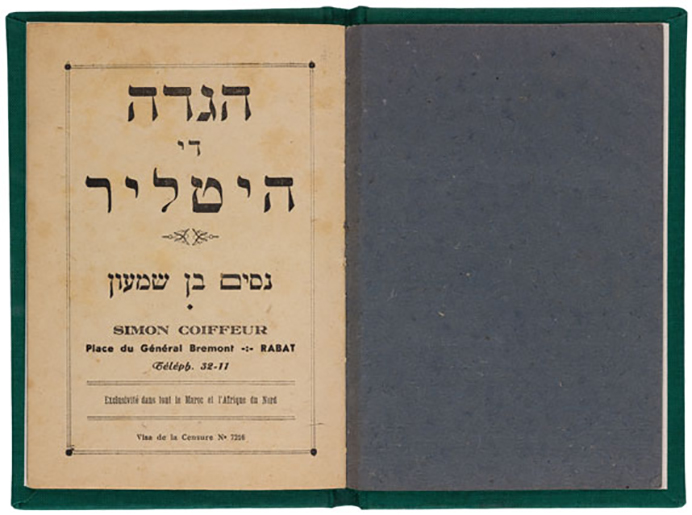Religion
The tale of Hitler’s Haggadah in Morocco

If you’re looking to add some novelty to your Pesach seder, why not consider bringing Hitler’s Haggadah to your table?
Before you express outrage, rest assured that the Nazi dictator didn’t own or publish his own Haggadah. This unique volume named after him was in fact penned by a Jew, and while it may not be a traditional Haggadah, it adds a meaningful dimension of salvation to the timeless account of Jewish redemption.
Called Hitler’s Haggadah, this supplemental text has garnered considerable attention in the press in recent years. It’s believed to have been written by a Jew called Nissim ben Shimon, also called Simon Coiffeur (Simon hairdresser) in French on the book’s cover, in Rabat, Morocco, in about 1943. It followed the 1942 Allied invasion, Operation Torch, that brought about an eventual Allied victory against the Axis powers in French North Africa.
In a novel spin on the Pesach story, the text recounts the events of that invasion, and frames them within the familiar narrative. Writing under what is probably a pseudonym, the author presents a wartime Pesach narrative in Judeo-Arabic, inserting large pieces of the original Haggadah text while injecting certain novelties into the narrative.
“He does actually what the sages have told us for generation upon generation: to see ourselves as if we are part of the exodus,” Jonnie Schnytzer, a PhD candidate at Bar-Ilan University, reportedly told American Jewish news outlet, The Forward, earlier this month.
Schnytzer discovered the text in 2019, and has since worked on translating and adapting it for re-publication this year under the title, The Hitler Haggadah: A Moroccan Jew’s Wartime Retelling of the Passover Story.
“[The author] suddenly sees ‘wow this is happening today’,” Schnytzer says. “The Allied forces, instead of G-d, are the ones that bring plagues upon Hitler, instead of Pharaoh. He’s retelling a story, the story of his generation, which is the Allied forces beating Hitler and Mussolini.”
While the text’s format is familiar, names and locations are often altered, with Rabbi Joseph Stalin asking how Berlin suffered 10 plagues and Hamburg a whopping 50; the Royal Airforce named as a plague; and Mussolini cast as the son who doesn’t know how to ask.
The Axis forces are treated similarly in the text, which poses the question: “This Italy that we are fighting, for what reason?” It goes on to explain, “Because of Mussolini, who stuck to Hitler, saying, ‘Be careful not to betray me.’ And He brought upon them Montgomery, and their dough didn’t even have time to turn into macaroni. And then the Eighth Army appeared, and they immediately fled.”
Comically, the writer adds that “they baked the dough and made spaghetti. When they kicked them out of Egypt, and they didn’t have time to shape [the dough]. Nor did they even have time to fast.”
Schnytzer writes in his blog at The Times of Israel that the text is “deep, dramatic, and sometimes comical”. “Above all, it carries an inspiring message of Jewish unity, solidarity, and a shared fate.
“One might think it’s tasteless to have chosen such a title, but bear in mind that Hitler’s Haggadah wasn’t a traditional Haggadah but more of a supplement, giving a rewritten take, a modern reading of the Magid section.”
Beyond that, the text is also a crucial window onto the oft neglected experience of North African Jewry during the war, addressing what Schnytzer calls a “black hole” of awareness. According to the Jewish Museum of Berlin, Jews living in North Africa were constantly threatened by the Germans during the North African campaign from 1940 to 1943. In the German-allied French colonies of the Vichy regime, racial laws and forced labour camps had already been established for the Jewish population.
Moreover, Nazi forces occupied Tunis for a time, establishing labour camps in which Jews perished from disease and lack of food. Morocco, too, faced the grim reality of anti-Jewish laws and ghetto confinement in some cases. Fortunately, the tables were turned by the Allied victory, a miracle and inspiration for the Haggadah’s author.
“It’s important for each of us to understand the narratives and stories of different groups, and ideally, for it to become part of how we see ourselves as Jews,” Schnytzer reportedly told The Forward.
“There’s an incredible message here, an inspirational message of Jewish solidarity, because he’s a Jew living in Rabat, in North Africa, and yet he’s worried about what’s going on with his brethren in Germany, in Poland.”
Thanks to Schnytzer’s efforts, the text has become widely available internationally, featuring unique artwork and an accessible translation. The project was initially backed and funded on the Headstart funding platform, but is now available for purchase on Amazon.
“When I first read Hitler’s Haggadah, I fell in love with the work,” Schnytzer writes on the Headstart page. “Not only because of its charm, but also because it opened a window into a whole new world for me, another piece of the diverse mosaic called the Jewish people.
“Hitler’s Haggadah, in spite of its name, is an opportunity to catch a glimpse into the part of the narrative of North African Jewry, precisely on a night whose sole purpose is to tell the story of our people – a people originally from one place, in time scattered across the globe and now, many generations later, which has a homeland once more.”
- ‘The Hitler Haggadah’ can be bought on Amazon at https://www.amazon.com/Hitler-Haggadah-Moroccan-Retelling-Passover/dp/1951324013